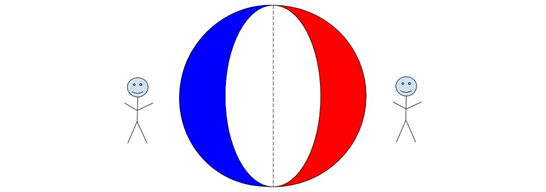Why the humble beach ball is the key to understanding others
Apr 25, 2022
When fools rush in
You’ve no doubt heard the phrase: Great minds think alike. It’s usually said as a follow-up when two or more people say something at the same time or have the same idea. There are several theories as to its origin but nothing concrete. Nonetheless, it’s a well-used phrase.
The thing is, is it always good when everyone thinks the same? Does it make those people right if they think the same? If so, in whose opinion? Usually by the ones who are all thinking the same!
Interestingly, ‘Great minds think alike’ isn’t the phrase in its entirety. With some research into its origins, apparently, the whole phrase is: 'Great minds think alike but fools seldom differ.’ This would seem to suggest that the people who come to the same conclusion aren’t so smart after all! It does support my point, as does the quote by US General George S. Patton: “If everyone is thinking alike, then somebody isn’t thinking.” In other words, if everyone is thinking the same, everyone is a follower rather than an innovator.
A friend of mine’s son attends a school for children who have special educational needs and the motto at the school is: ‘Great minds think differently.’ I absolutely love this ethos- not just for the children at that school to live by, but for all to understand.
The term Neurodiversity describes the idea that everyone experiences and interacts with the world around them in a myriad of different and sometimes complex ways, and therefore there is no ‘right’ way of thinking, feeling, behaving or learning. Differences aren’t seen as ‘not normal’ because after all, what is normal?
As author Patsy Clairmont once said:
"Normal’ is just a setting on your dryer."
Imagine a team at work where everyone is thinking the same ideas, has the same theories- where is the innovator, the creator, the disruptor? These are the individuals who question the status quo, who mix things up a bit. They’re the blue-sky thinkers, the ones who think outside the box and whose thoughts inspire others to be braver and bolder with their thinking.
You’re always going to need those who lead, who are prepared to be unpopular because they ensure everyone knuckles down to get the job done; the leader listens, delegates, teaches, inspires, mentors and coaches, and they ensure everyone is on board with the task in hand– the why, the what and the how.
You’ve the worker bees who get the job done. They know the part they play- and as long as you have their buy-in i.e. they understand the why, the what and the how, they will want to play their part in getting it across the finish line. It reminds me of the story of the three stonemasons. There are various versions, but the premise is that a traveller happens upon some men working and asks what they are doing. The first man replies that he is working on carving some stone and seems fairly disinterested in his own work. The second man is asked, and he replies that he is building a wall. He seems committed but somewhat weary of the task. The third stonemason is excited to explain that he is doing his bit to build a great cathedral that might not be finished in his lifetime but that will be enjoyed by many in years to come.
The third stonemason clearly knew the part he played in the process and therefore was proud of his input. A leader inspires that enthusiasm by helping their team to understand their contribution.
The mavericks are the ones who question, who disrupt the current ways of thinking. They may suggest off the wall ideas but perhaps their brain works in a different way and it’s their ideas which challenge the norms and innovate. Its ‘aim don’t tame’ with team members who want to do things differently because great minds think differently.
Thinking outside the box
An example springs to mind of when my three children were chasing their Dad around the house, determined to catch him but he kept outwitting them. He then ran into the downstairs cloakroom with the door firmly closed behind him. My eldest and youngest tried the door but realising it was locked, thought is was game over. Not my middle daughter though. She looked around, saw 2p on the bookcase and used it to turn the lock on the door. She is the one who thinks outside the box, she is the one with the most creative thinking that sometimes we have a window into when she shares her off the wall thoughts. I’d love to be in her head – it’s an awesome place to be!
I say ‘aim don’t tame’ that maverick energy- because very often, rather than utilise that vision and creativity of those who think differently, the ones who all think alike might feel threatened, even the manager, and so that team member might not be recognised for their ingenuity.
What I struggle with is when people use the phrase ‘great minds think alike’ to validate their thinking, without wondering whether there is a different way of looking at things.
Imagine there are eight people in a team; seven think the eighth is awkward because they don’t agree with popular idea because they present an alternative view. Is the eighth person awkward? No. It’s just that seven people agree with each other. Maybe the other seven could ask themselves why the eighth doesn’t agree, rather than why they should agree with the rest.
A successful team requires a number of elements such as collaboration, cooperation, listening, contribution, support, trust, and leadership. But you are only ever going to get all of those when there is understanding, respect and acceptance of everyone’s differences. Uniqueness brings with it different experiences, knowledge, skills, values, and ideas.
A new understanding
One tool we talk about on the Winning Edge, which can help you to understand another’s point of view, is the Beach Ball:

If I ask the person on the right what colour the ball is, what would they say? They’d say it’s red and white. The person on the left? They’d say it’s blue and white.
So, what colour is the beach ball? Red, blue and white? How do you know? You can’t see round the other side!! There could be even more colours…
So, to clarify, two people are telling what they think is the truth, and they are both wrong!?!
If you want to know more of what is going on in any situation, or to understand another person’s point of view, you have no choice but to go around the other side of the beach ball, to look at things from their perspective. We don’t need to like what we see but it's important to know what’s there in order to be able to build a relationship.
As Stephen Covey said:
“Seek first to understand before asking to be understood.”
You probably know that top barristers prepare the case for the opposition first. Could you make the case for every customer complaint you receive? I mean really be able to argue their side with conviction. Because in business it’s no use only selling or pleasing customers who have similar values to yours – it's important to flex your thinking and relate to everyone.
Perhaps there’s someone in your personal life for whom you could both benefit by you going around the other side of the beach ball?
The Beach ball is a great tool not only for aiding effective communication with colleagues, but also to understand when uncovering your client or customer’s emotional needs and values- their reasons for buying or not buying. Getting round to their side of the Beach ball means you are understanding their buying decisions, which of course are always based on emotional reasons - they move to emotional ease when they decide to buy. For all those who work in sales who are reading this, I’m sure you all know or have a list somewhere of all the emotional reasons people buy your product don’t you- like arrows in your quiver, you pick the right one at the right time. What’s the emotional connection? What’s the want, not the need? Needs and wants are entirely different.
Whether it be an individual in a team, a client or customer, or someone in your personal life, who is thinking differently to you, before deciding that they are ‘wrong’ or being awkward, ask yourself what you have done to look at things from their perspective. Does getting round to the other side of the Beach ball help you to understand things more clearly? Might they be offering an interesting alternative way of doing things because of the way they think differently from you? I think it’s always worth asking yourself the question…
. . . . . . .
Do you find it challenging to understand another’s perspective? Is it your way or the highway?
Perhaps strengthening relationships is something you’d like to focus on in 2022– both personally and professionally.
The Mindset Coaching Membership can help you understand the tools and strategies needed. With Masterclass Teachings + Coaching + Accountability, we will help you to create the future you want. Find out more here.
Follow us on Facebook
Follow us on LinkedIn
Follow us on Instagram
Subscribe today!
Supercharge your mindset with our Mindset Blog...
We do not SPAM and we will never sell your information, for any reason.

